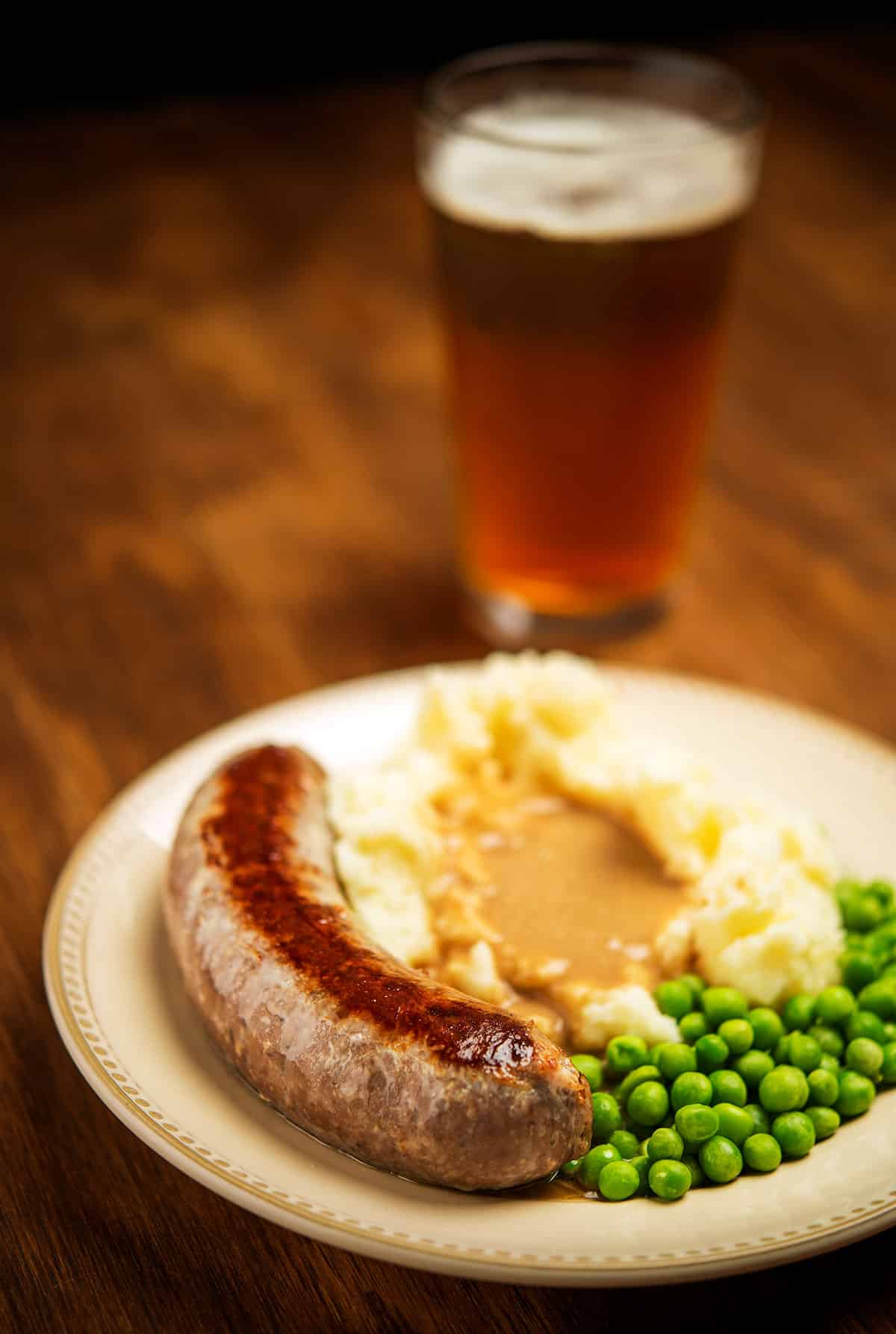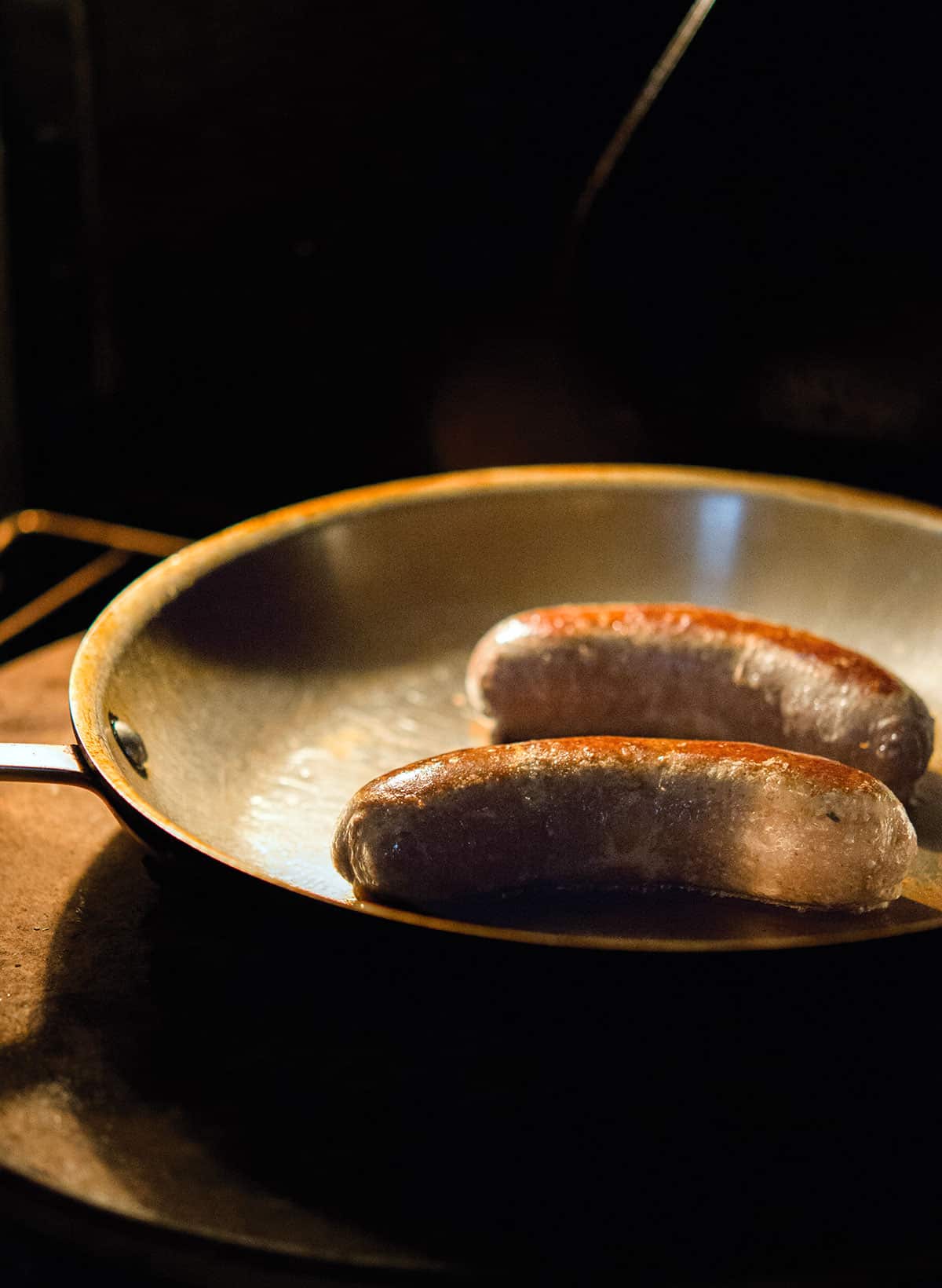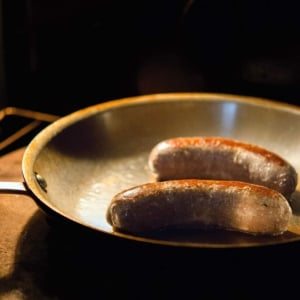Homemade British Bangers Sausage
October 09, 2014 | Updated June 06, 2022
As an Amazon Associate I earn from qualifying purchases.
English bangers sausage is an easy to make, mild sausage that is most famously served with mashed potatoes — the famous “bangers and mash.” Here’s how to make bangers sausage at home.

I can’t remember the first time I had bangers and mash, but if I had to guess it would be at Lily Flanagan’s, an Irish pub in Islip on Long Island, back in the early 1990s. I just remember it as generic “sausage,” with nice mashed potatoes and peas.
Later, in 1995 on a 36-hour layover in London, I had real deal bangers sausage. Still pretty generic, but definitely better: It was a softish link, with warm spices and an interesting bind that made it comforting to eat.
I later learned that the unusual mouthfeel of bangers sausage is caused by the inclusion of some sort of grain product in the link, whether crushed rusks, oats, barley or breadcrumbs. I’ve heard various theories on why British charcuterie does this — virtually no other sausage-making nation does, with the exception of the famous Scandinavian potato sausage — ranging from scarcity during the World Wars to, well, it just tastes good. I used to think it was some sort of scandalous cheapening of a good sausage, but I’ve come around recently.
The addition of a grain in the mix can and does add something positive. Texture, sure, but also flavor. I am partial to barley or oats coarsely ground in a coffee grinder.

Now before you Brits cross the Atlantic on some fool’s errand again (lest we forget 1776 and 1812) know that I am well aware that there is no One True Banger, just as there is no one recipe for Italian sausage or Polish kielbasa. (Although if I had to give the title of One True Banger it’d probably go to Mick Jagger…)
My version of bangers sausage is derived from recipe for a Gloucester-style sausage I found in the books Manual of a Traditional Bacon Curer and British Charcuterie. Both are worth your time, with Manual as the more comprehensive.
Some bangers recipes are all pork, some are pork and beef. I used blacktail deer and pork. This particular deer had grown fat from eating black oak acorns, so I added some to the sausage mix. Deer fat, by the way, can be awfully good in moderation. (More on that here.)
For the grain element, I used oats ground into a meal. Traditionally, you’d use “rusk,” which are dry biscuits or bread baked hard. Regular breadcrumbs work fine. I also use a little porcini powder, which is not traditional, but it tastes really good.
I used beer instead of ice water to help the sausage bind. I went with an English mild beer, which is very malty and low in alcohol. Any malty beer will work, or use ice water.
Everything went well. The bind of the bangers sausage was perfect — tight, almost emulsified — and had that snap when you bite into them. The filling was moist, meaty, venison-y and laced with all those warm spices. A damn good banger, if I do say so.
New to making sausage? You can find my detailed tutorial on how to make sausages at home here.
Looking for something to serve bangers with? I like colcannon, maybe a side of pickled walnuts, and a parsley sauce on the side.
British Bangers Sausages
Ingredients
- 4 pounds venison, pork or other meat cut into chunks
- Either 1 pound pork fat (or 1/2 pound pork fat and 1/2 pound venison fat), cut into chunks
- 36 grams kosher salt, about 2 tablespoons plus a teaspoon
- 2 teaspoons dried thyme
- 2 teaspoons white pepper
- 1 teaspoon minced sage
- 1 teaspoon porcini powder (optional)
- 1 teaspoon onion powder
- 1/2 teaspoon mace
- 1/2 teaspoon nutmeg
- 1 cup coarsely ground oats, barley, or, alternately breadcrumbs
- 3/4 cup malty beer
- Hog casings
Instructions
- Get out about 15 to 20 feet of hog casings and soak them in warm water. If you don't trust your source, run water through them to check for punctures or weak spots.
- Make sure all your equipment is cold, as in freeze the grinding plate and blades, and the bowl you will put the meat into for 30 minutes to an hour. Do the same for the meat and fat. When everything's nice and cold, mix the meat and fat with all the spices (leave out the oats and beer for the moment).
- Grind it all through a coarse plate; I use a 10 mm plate. Test the temperature of the mixture, and if it's 35°F or colder, go ahead and grind it all again through a fine die, like a 4.5 mm or somesuch. If it's warmer than 35°F, put the mix back in the freezer to chill. This might take an hour or so if you've let the meat warm up too much.
- Once the sausage has been ground twice, test the temperature again to make sure it's 35°F or colder. I prefer to chill the mix down to 28°F to 32°F for this next stage. Chill the mix and when it's cold enough, take it out and add the oats and beer. Now, mix and knead this all up in a big bin or bowl with your (very clean) hands for a solid 2 minutes -- your hands will ache with cold, which is good. You want everything to almost emulsify.
- Stuff the sausage into hog casings rather loosely. I like bangers to be about 6 to 8 inches long, but it's your choice. To twist them into links, tie off one end of the coil you just made. Pinch off links with your two hands and roll the link between them forward a couple times. Move down the coil and repeat, only this time roll backwards a few times. Repeat until you do the whole coil. (This video shows how I do it.) Now look at the links, which will probably have air pockets in them. Use a sterile needle or sausage pricker (set it aglow in your stovetop flame) to puncture the casing over all the air pockets. Gently compress the links together to squeeze out the air pockets and rotate the links a bit more to tighten; this takes practice.
- Hang your links for at least 1 hour if your room is warm, and up to overnight if you can hang them in a place that's 40°F or cooler. Don't let them freeze yet. If you are not hanging overnight, let the sausages continue to dry uncovered in the fridge overnight before you seal them up and freeze. Bangers will keep a week in the fridge and a year in the freezer, if you've vacuum sealed them.
Notes
Nutrition
Nutrition information is automatically calculated, so should only be used as an approximation.






Tried this recipe today. Tastes awesome thank you!
I have a slight bias here, being a native of Cumbria, but for “sausage and mash” I prefer a Cumberland Sausage. Much coarser ground, thicker and more heavily spiced that the average British sausage, it works really well with mashed potato. For peas, it has to be Marrowfat, which seem to be hard to find outside the UK (I ended up paying $4 a can for them at the import shop in Seattle when I lived there. a 600% mark up on the price)
Paul would you mind sharing your Cumberland sausage recipe with me And do you make your own bread/biscuits for the rusk? Thank you.
I am newer to sausage making and am very happy to have found this recipe. We made a pork version this past weekend and it they were delicious.
We used pork shoulder, which was a tad on the lean side, and added in lard. We didn’t have mace so I substituted 1/4 tsp of additional nutmeg instead. I might increase that slightly next time, I just didn’t want the nutmeg to be overpowering since it is more potent.
The one question I have is about the stickiness/texture of the pork mixture. We followed the quantities in the recipe and found it was sticky enough to be difficult to run through our machine to stuff the casings. My shoulders were killing me from trying to press the mixture through the grinder and any time I had to pull out my presser (not sure what it’s called, the thing to press the meat into the grinder) it created a vacuum which pulled the meat back into the grinder. Once we got going, the meat wouldn’t suck back into the grinder, but it was still a huge struggle to press it through and to pull the presser back out so that we could add more meat.
I noticed that a bread I baked earlier in the day needed less flour than usual because it was dry and I’m wondering if this is the same case for the sausage. It is January in Canada and the air is less humid than usual – but outside of bread baking I’ve never given the impact of my environment on my food much thought. It could also be that we are using a Kitchenaid stand mixer with the meat grinder/sausage making attachments. We’re not quite at the level to justify more expensive equipment (yet!).
Just finished up a batch and of course we had to sample our work. Very good. The oatmeal does give them a distinctive texture. Reminded me of what we ate every morning while in Ireland a couple years ago.
I’ve been looking for a good banger recipe using deer and this is it. Thanks they turned out great!
The Icelandic make a banger-like thing called Lifrarpylsa, one recipe I saw contained: lamb liver, sheep suet, rye flour, oatmeal, onion, herbs, salt and milk. They’re simmered in water for around 2 hours. Similar to ‘white pudding’ or ‘mealy pudding’ or even haggis. Grain and offal puddings are traditional in the North and West of England, Wales, Scotland and Ireland ( i.e. all of the poorer areas).
Hank,
Nice post. I love bangers. The Portuguese, frugal folk who are rather famous for recycling stale bread in creative ways, also make sausages with the addition of bread crumbs, for example alheira and farinheira.
I worked making sausages and Hulani is right. Rusk is the secret to making a traditional Banger Irish or English any way!
Scott: Not entirely true. As you may suspect, different sausage makers in different parts of the United Kingdom use different ingredients. Sure, rusk is absolutely common, but I have seen plenty of bangers recipes that use oats or barley, which is what I use. Mostly from Scotland.
Thanks again. The 1960s in Hong Kong BCC (british crowned colony) introduced me to variations of Brit Bangers & Mash compared to my heritage Socttish Bangers (oft Venison,lamb and meat combos). one thing the brit verisons all had in common was Rusk. Yes the Scots may use Oats, Barley noone uses breadcrumbs per se for the simple reason (they claim) theyre not dry enough.
LOL. Rusk is almost made exclusively for Banger recipes! The idea is they all say that Rusk or barley or oats will hold the fat or flavour. I now make Bangers without any filler, oh blasphemy!
Local Banger varieties around the Isles have differing herbs with an “h” Lol…enjoy! I recommend Scott Rea on you tube for best Rusk, perhaps discussions of Scottish V Brit V Irish V welsh bangers.
Hey Hank,
Came across a bangers recipe where they boil the sausages for 20 mins before cooking them. I tried it out and it was successful. my question is can I freeze the boiled sausages after?
Tarek: Yes, you sure can.
I have just completed a batch of Banger Sausages using your recipe.
My question to you is this; in the ingredients list, did you mean 8 ounces of ground oats, as in one cup, or 8 ounces as in half a pound?
At first I ground a cup’s worth (8 ounces) of oats….then it struck me that you must mean by weight, and so that is what I ended-up putting into the mix.
Correct me if I’m wrong, but I think I made the wrong choice.
These are incredibly bready sausages.
Have I screwed these up badly, or is this really your interpretation of Banger Sausages?
Doug: It is a cup. Sorry about that!
I did this same thing 🙁 and 8oz of weight of breadcrumbs is double what a cup is. Sadly I now have 5 lbs of this stuff and I’m definitely not in love with it. Oh well, sausage making is an experimental process.
Travis: Sorry, man. I have since fixed that recipe to state 1 cup.
Hank, I ended up slicing open the casings and made meat loaf out of it. It was great!
Great flavor and texture borderline to saltybut just enough salt to make the flavors pop. Very good with hash and eggs haven’t tried mash and peas.
Hi Hank,
I’m new to sausage making. I took a local sausage making class and now have some elk sausages – 50% elk, 50% pork plus various spices (chorizo, Italian and bratwurst). I was wondering if I can cook them in my smoker. It’s a stove top smoker from Nordicware (new product). I don’t know how long I should leave them in the smoker. Any suggestions on temperature and time, dry or wet smoking?
Christine
Christine: not sure. I have never used a stove top smoker.
Ok that should be Bloody Mary, but the computer knows better than me.
This is my basic recipe:
2500g Pork
250g oats (blitzed) 10% of meat
50g Salt 2% of meat
10g White pepper (cook off a sample and taste with half this amount first)0.4%
5g Black pepper0.2%
1g Mace0.04%
2g Dried Sage 0.08%
250G liquid 10% (water, Beer could be apple juice (but might burn when cooking))
I always dice the meat ready for mincing then add the seasoning before mincing, allow to rest in the fridge for an hour or more. Mince through a coarse plate then a fine plate
Add Chile flakes, fennel seeds and Garlic to the above (before mincing, only a coarse then medium plate) and halve the grain/bread for a good sausage to cut up and throw in a pastsa sauce
Hi,
the filler of cereal, I use regular oatmeal blitzed in a processor to a fine, consistency otherwise I use breadcrumbs from the odd ends of my homemade bread, could be a sourdough, plain white or a rye blend.
Point is (and made earlier by others) the cereal will hold on to the juice and fat in the sausage; guess where the flavor is.
I add simple water for the liquid content but if to want to add beer, give Newcastle Brown a chance. I would do a half and half batch and add Newcastle Brown to half my mix and plain water to the other. Yo can then decide if it would be better to drink the beer when eating the sausage!
Also go find real Mace, it its so different from its sibling nutmeg.
I am based in Worcestershire as in the sauce for you bloody martini, make lots of sausage, salami and whole muscle cures, using local produce, Gloucester old spot.
My top tips:
get the best meat you can afford
use fresh herbs and spices, blitz them as late in the process you can then add to the cut (1″ pieces, include all the soft fat you have) meat, ready for mincing. Chill for two hours then mince trough a coarse plate (6 mm 1/4″) Add cereal and liquid of your choice then mix well, like kneading dough Or very slow in a machine until the mix comes together like dough almost. Cover and leave to rest for an hour or so, take a sample to cook and check the seasonig
Getting ready to try recipe, but one question. Are the oats rolled oats or steel cut oats? I used to work in a British Pub, and loved the bangers and mash, but they had the bangers made for them by a local butcher. Can’t wait to try this recipe
Douglas: Either work, but I use steel cut, and grind them to a flour/powder.
These taste great, I made a batch yesterday. How do I stop them from bursting and the filling pouring out? Did I overstuff them?
James: Yes, you overstuffed them.
That’s why they are called bangers, they go BANG and explode!
Hank what would be a good beer to use in this recipe?
Both Brit & American?
John: Something malty, like a Scottish ale, a brown ale or even a porter or stout.
Hi, yes it does my bad.
You said you ere all ears about other books on the subject well this is a good one.
https://www.amazon.com/Manual-Traditional-Bacon-Maynard-Davies/dp/1906122083/ref=pd_bxgy_14_img_y
Also this guys butchery videos are quite entertaining.
https://www.youtube.com/watch?v=WFhSH18MVOo